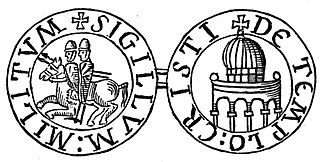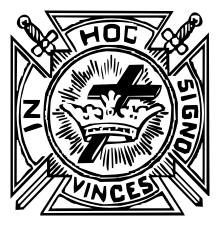
The Poor Fellow-Soldiers of Christ and of the Temple of Solomon, also known as the Order of Solomon's Temple, the Knights Templar or simply the Templars, were a Catholic military order founded in 1119, headquartered on the Temple Mount in Jerusalem through 1128 when they went to meet with Pope Honorius II. They were recognized in 1139 by the papal bull Omne datum optimum. The order was active until 1312 when it was perpetually suppressed by Pope Clement V by the bull Vox in excelso.

Hugues de Payens or Payns was the co-founder and first Grand Master of the Knights Templar. In association with Bernard of Clairvaux, he created the Latin Rule, the code of behavior for the Order.

Baphomet is a deity that the Knights Templar were accused of worshipping, and that subsequently was incorporated into occult and mystical traditions. The name Baphomet appeared in trial transcripts for the Inquisition of the Knights Templar starting in 1307. It first came into popular English usage in the 19th century during debate and speculation on the reasons for the suppression of the Templars.

A military order is a Christian religious society of knights. The original military orders were the Knights Templar, the Knights Hospitaller, the Order of Saint James, the Order of Calatrava, and the Teutonic Knights. They arose in the Middle Ages in association with the Crusades, both in the Holy Land and in the Iberian peninsula; their members being dedicated to the protection of pilgrims and the defence of the Crusader states. They are the predecessors of chivalric orders.
The Templars are an Oi! band formed in Long Island, New York in April 1991. The band's musical influences include Oi!, punk rock, glam rock and rock and roll. They have tended to purposely use low-quality recording techniques.

The Military Order of Christ, previously the Order of the Knights of Our Lord Jesus Christ, is the former Knights Templar order as it was reconstituted in Portugal after the Templars were abolished on 22 March 1312 by the papal bull, Vox in excelso, issued by Pope Clement V. The Order of Christ was founded in 1319, with the protection of the Portuguese king, Denis, who refused to pursue and persecute the former knights as had occurred in most of the other sovereign states under the political influence of the Catholic Church.
The Grand Masters of the Knights Templar during the later 12th and the 13th century used a double-sided seal which showed a representation of The Dome of the Rock on one side, and the Order's symbol of two knights on one horse on the other side. This design is first attested as in use by Bertrand de Blanquefort, the order's sixth Grand Master, in 1158, forty years after its foundation, and it remained in use until the dissolution of the order in 1312.

The Sovereign Military Order of the Temple of Jerusalem,, is a self-styled order and international NGO. OSMTH is often referred to simply as the Knights Templars but asserts no direct lineage to the original Order. OSMTH does not officially recognize the claims laid out in the Larmenius Charter as historically valid, but makes a moral and ethical claim to follow in the same spiritual path as the original Order of the Knights Templar. OSMTH, which is open to Christians of any denomination, operates as a charity.

The Militia Templi, also called the Order of the Poor Knights of Christ, is a lay order of the Roman Catholic Church.

Poggibonsi is a town in the province of Siena, Tuscany, central Italy. It is located on the Elsa River and is the main centre of the Valdelsa Valley.

The Knights Templar, full name The United Religious, Military and Masonic Orders of the Temple and of St John of Jerusalem, Palestine, Rhodes and Malta, is a fraternal order affiliated with Freemasonry. Unlike the initial degrees conferred in a regular Masonic Lodge, which only require a belief in a Supreme Being regardless of religious affiliation, the Knights Templar is one of several additional Masonic Orders in which membership is open only to Freemasons who profess a belief in Christianity. One of the obligations entrants to the order are required to declare is to protect and defend the Christian faith. The word "United" in its full title indicates that more than one historical tradition and more than one actual order are jointly controlled within this system. The individual orders 'united' within this system are principally the Knights of the Temple, the Knights of Malta, the Knights of St Paul, and only within the York Rite, the Knights of the Red Cross.
Poor Knights names various groups:

There are Masonic degrees named after the Knights Templar but not all Knights Templar Orders are Masonic.

The Castello della Magione is a medieval castle in Poggibonsi. It is an example of a medieval "Mansio" (residence) that belonged to the Knights Templar. The castle includes the ancient church and the “spedale” (hotel) for the pilgrims in transit to Rome on the Via Francigena. The complex is near the ancient crossing of the Via Francigena over the Staggia River, near the Bonizio bridge, now destroyed.
The original historic Knights Templar were a Christian military order, the Order of the Poor Fellow Soldiers of Christ and of the Temple of Solomon, that existed from the 12th to 14th centuries to provide warriors in the Crusades. These men were famous in the high and late Middle Ages, but the Order was disbanded very suddenly by King Philip IV of France, who took action against the Templars in order to avoid repaying his own financial debts. He accused them of heresy, ordered the arrest of all Templars within his realm, and had many of them burned at the stake. The dramatic and rapid end of the organization led to many stories and legends developing about them over the following centuries. The Order and its members increasingly appear in modern fiction, though most of these references portray the medieval organization inaccurately.
Keele Preceptory was a preceptory, in Keele, Staffordshire, England. Owned by the Knights Templar until their suppression in the early 14th century, it then passed through a number of owners before falling into the hands of the Knights Hospitaller.
The Larmenius Charter or Carta Transmissionis is a Latin manuscript purportedly created by Johannes Marcus Larmenius in February 1324, detailing the transfer of leadership of the Knights Templar to Larmenius after the death of Jacques de Molay. It also has appended to it a list of 22 successive Grand Masters of the Knights Templar after de Molay, ending in 1804, the name of Bernard-Raymond Fabré-Palaprat appearing last on the list. The document is written in a supposed devised ancient Knights Templar Codex. Actually in Freemason custody, the document is kept at the Mark Masons Hall in London. Based on analysis of the deciphered code as well as of the circumstances of the finding of the charter, most researchers have concluded that it is a forgery.
The history of the Knights Templar in England began when the French nobleman Hughes de Payens, the founder and Grand Master of the order of the Knights Templar, visited the country in 1128 to raise men and money for the Crusades.










